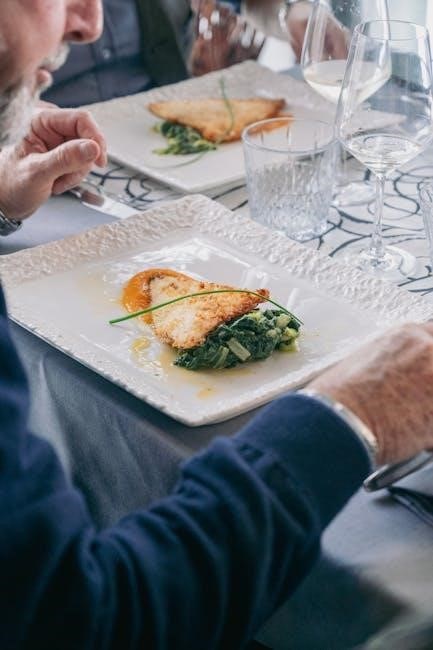Ungars Gefilte Fish Instructions: A Comprehensive Guide
Ungars Gefilte Fish offers a convenient way to enjoy a traditional dish. This comprehensive guide provides step-by-step instructions for preparing Ungars Gefilte Fish, whether you prefer boiling or baking. Discover the secrets to achieving a flavorful and perfectly textured gefilte fish every time, ensuring a delightful culinary experience.
Ungars Gefilte Fish presents a modern solution to a classic Jewish culinary tradition, offering a flavorful combination of whitefish and pike reminiscent of old-world recipes. This introduction will guide you through understanding and preparing Ungars Gefilte Fish, a convenient alternative to time-consuming homemade versions.
Whether you’re a seasoned gefilte fish enthusiast or a newcomer to this delicacy, Ungars’ ready-made loaf simplifies the process without compromising taste. Using a frozen fish loaf eliminates the need for grinding, mixing, and shaping, making it accessible to all.
This guide covers everything from ingredients to cooking methods, including both boiling and baking instructions, ensuring a perfect outcome every time. You’ll learn about oven temperatures, simmering times, serving suggestions, and even troubleshooting common issues.
Ungars Gefilte Fish typically contains whitefish, pike, or mullet, eggs, onions, sugar, matzo meal, canola oil, potato starch, salt, and spices. Preparation is straightforward, offering options to suit your preferences.
Discover how to transform a frozen loaf into a delicious, traditional dish with minimal effort. Whether served hot or cold, with horseradish or other condiments, Ungars Gefilte Fish is a versatile and satisfying addition to any meal. This guide will empower you to confidently prepare and enjoy this classic dish.
Understanding Gefilte Fish: Origins and Variations
Gefilte fish, meaning “stuffed fish,” is a traditional Ashkenazi Jewish dish with roots in Eastern European cuisine. Historically, it involved stuffing fish skin with a mixture of ground fish, onions, and spices, creating a flavorful and visually appealing presentation. Over time, the dish evolved, and the “stuffing” is now commonly formed into loaves or patties.
The primary purpose of gefilte fish was to stretch the use of expensive fish and remove bones for easier consumption on the Sabbath. Various regional variations exist, reflecting local ingredients and preferences. Some recipes lean towards sweetness, while others are more savory. Common ingredients include whitefish, pike, and carp, often combined to achieve a balanced flavor.
Ungars Gefilte Fish represents a convenient adaptation of this classic dish. It offers a pre-made option that captures the essence of traditional gefilte fish without requiring extensive preparation. While homemade versions allow for greater customization, Ungars provides a consistent and reliable alternative.
Whether boiled or baked, gefilte fish is typically served cold or at room temperature, often accompanied by horseradish. Understanding the origins and variations of gefilte fish enhances appreciation for this cultural staple and the convenience offered by brands like Ungars. This knowledge allows you to tailor your serving and condiment choices to best suit your taste.
Ingredients of Ungars Gefilte Fish
Ungars Gefilte Fish features a carefully selected blend of ingredients designed to replicate the traditional flavors of this classic Jewish dish. The primary components typically include a mixture of whitefish and pike, providing a delicate and subtly sweet taste. In some variations, mullet may also be incorporated to enhance the texture and flavor profile.
To bind the mixture and create a cohesive loaf, Ungars Gefilte Fish utilizes eggs and matzo meal. Matzo meal, derived from wheat flour, contributes to the dish’s characteristic texture and helps maintain its shape during cooking. Potato starch is also added as a thickening agent, ensuring a moist and tender consistency.
The flavor profile of Ungars Gefilte Fish is further enhanced by the inclusion of onions, sugar, salt, and a proprietary blend of spices. Expeller-pressed canola oil is used for added moisture and richness. These ingredients work in harmony to create a balanced and flavorful dish that evokes the traditional taste of homemade gefilte fish.
It’s important to note that Ungars Gefilte Fish is produced in a facility that also processes wheat, soy, eggs, fish, and milk. Therefore, individuals with allergies to these ingredients should exercise caution. Always review the packaging for the most up-to-date ingredient list and allergen information before consumption. Understanding the ingredients allows consumers to make informed choices.
Nutritional Information: Carbs and Sodium Content
Understanding the nutritional content of Ungars Gefilte Fish is essential for making informed dietary choices. This section focuses on the carbohydrate and sodium levels, providing valuable information for those monitoring their intake of these nutrients.
Ungars Gefilte Fish typically contains approximately 3.0 grams of carbohydrates per serving. This relatively low carbohydrate content makes it a suitable option for individuals following low-carb diets or managing blood sugar levels. However, it’s important to consider the serving size and any accompanying condiments, as these can contribute additional carbohydrates.
Regarding sodium, Ungars Gefilte Fish has a higher content, with approximately 180.0 milligrams per serving. Sodium is a mineral that plays a crucial role in various bodily functions, but excessive intake can contribute to high blood pressure and other health concerns. Individuals with sodium-sensitive conditions, such as hypertension or kidney disease, should be mindful of their sodium consumption and adjust their portion sizes accordingly.

When incorporating Ungars Gefilte Fish into your diet, it’s recommended to balance it with other low-sodium foods and to adhere to recommended daily sodium intake guidelines. Consulting with a healthcare professional or registered dietitian can provide personalized guidance on managing carbohydrate and sodium intake based on your individual health needs and dietary requirements. Always refer to the product packaging for the most accurate and up-to-date nutritional information.
Preparation Methods: Boiling Instructions

Boiling is a traditional method for preparing Ungars Gefilte Fish, resulting in a tender and flavorful dish. This section provides detailed instructions on how to boil Ungars Gefilte Fish effectively.
First, remove the outer wrapper and tray from the frozen Ungars Gefilte Fish loaf. Place the frozen fish, still in its inner wrapper, into a pot of boiling water. Ensure there is enough water to fully submerge the fish. Bring the water back to a boil, then reduce the heat to a gentle simmer.
Simmer the fish for approximately one hour, maintaining a low and steady heat. This allows the fish to cook thoroughly and evenly. After simmering, carefully remove the fish from the water. Discard the inner wrapper and drain any excess liquid.
Allow the Ungars Gefilte Fish to cool completely before refrigerating. Once cooled, the gefilte fish is ready to serve. Boiling Ungars Gefilte Fish creates a classic, moist texture that complements traditional accompaniments like horseradish.
For an enhanced flavor, consider adding aromatics to the boiling water, such as carrots, onions, sugar, salt, pepper, and garlic. These additions infuse the fish with a subtle sweetness and savory depth. Remember to adjust simmering time based on the size of the loaf, ensuring it is cooked through. Enjoy your homemade gefilte fish!
Preparation Methods: Baking Instructions
Baking Ungars Gefilte Fish offers a delightful alternative to boiling, enhancing its texture and flavor. This section outlines a straightforward method for baking Ungars Gefilte Fish to perfection.

Begin by preheating your oven to 350 degrees Fahrenheit (175 degrees Celsius). Grease a 9×13 inch baking dish to prevent sticking. Remove the frozen gefilte fish loaf from its packaging. For easier removal of the parchment paper, let the fish rest at room temperature for about 5-10 minutes.
Place the frozen gefilte fish loaf in the greased baking dish. Cover the dish tightly with foil to retain moisture during baking. Bake for approximately 30 minutes, or until the fish is heated through.
Alternatively, for a browned top, heat oil in a large skillet over medium heat. Cook the gefilte fish for 5-7 minutes per side, until golden brown. Add chicken broth to the skillet and bring to a boil for added moisture.
Baking Ungars Gefilte Fish provides a less soggy texture compared to boiling, resulting in a more flavorful and appealing dish. Serve hot or cold, with a side of horseradish or chrain for a traditional touch. This method simplifies the preparation process while maintaining the authentic taste of homemade gefilte fish.
Oven Temperature and Baking Time
Achieving the perfect baked Ungars Gefilte Fish hinges on precise oven temperature and baking time. This section details the optimal settings to ensure your gefilte fish is cooked thoroughly and evenly, retaining its delicate flavor and texture.
For baking Ungars Gefilte Fish, preheat your oven to 350 degrees Fahrenheit (175 degrees Celsius). This temperature allows the fish to cook gently, preventing it from drying out while ensuring it reaches a safe internal temperature.
Once the oven is preheated, place the frozen gefilte fish loaf in a greased baking dish. Cover the dish tightly with aluminum foil to trap moisture and prevent the surface from browning too quickly.
Bake the gefilte fish for approximately 30 minutes. This baking time is generally sufficient for heating the fish through without overcooking it. However, baking times may vary slightly depending on your oven.
To ensure the gefilte fish is fully cooked, insert a fork into the center. It should feel warm to the touch. If the fish is still cold in the center, continue baking for an additional 5-10 minutes, checking periodically;
Proper oven temperature and baking time are crucial for achieving a perfectly cooked, flavorful Ungars Gefilte Fish.
Stovetop Simmering Time and Process
The stovetop simmering method offers a classic approach to preparing Ungars Gefilte Fish, yielding a moist and flavorful result. This section provides a detailed guide to achieving gefilte fish perfection through careful simmering.
To begin, select a pot large enough to accommodate the Ungars Gefilte Fish loaf comfortably. Fill the pot with water, ensuring the loaf will be fully submerged. Add seasonings such as salt, pepper, sugar, sliced onions, carrots, and garlic cloves to enhance the flavor of the fish.
Bring the water to a boil, then gently place the frozen Ungars Gefilte Fish loaf, still in its inner wrapper, into the boiling water. Once the loaf is in the pot, reduce the heat to a low simmer.
The key to successful stovetop simmering is maintaining a gentle heat. Avoid a rolling boil, as this can cause the fish to become tough and dry. Aim for a gentle simmer, where small bubbles rise to the surface occasionally.
Simmer the Ungars Gefilte Fish for approximately 1 hour, or 90 minutes, ensuring it is heated through.
After simmering, carefully remove the fish from the water, discard the inner wrapper, and drain any excess liquid. Allow the gefilte fish to cool before refrigerating.

With careful attention to simmering time and temperature, you can create a delicious, traditionally prepared Ungars Gefilte Fish.
Serving Suggestions: Hot or Cold?
Ungars Gefilte Fish presents a versatile culinary experience, offering the option to be enjoyed either hot or cold, depending on personal preference and the occasion. This section explores the nuances of serving Ungars Gefilte Fish at different temperatures, providing insights to enhance your dining pleasure.
Traditionally, gefilte fish is often served chilled or at room temperature, making it a popular appetizer or side dish, especially during Jewish holidays. When served cold, the flavors meld together, creating a refreshing and satisfying taste. Chilling the gefilte fish also firms up the texture, making it easier to handle and slice.
However, serving Ungars Gefilte Fish hot offers a different dimension to its flavor profile. Heating the fish gently can intensify its savory notes, making it a comforting and hearty dish. Some prefer to serve it hot, particularly during colder months or as a main course alternative.
Whether you choose to serve it hot or cold, consider pairing Ungars Gefilte Fish with appropriate accompaniments to complement its flavor. Horseradish, known as chrain, is a classic condiment that adds a spicy kick, while a simple carrot slice provides a touch of sweetness and visual appeal. Ultimately, the decision of whether to serve Ungars Gefilte Fish hot or cold rests on your individual taste and the context of the meal.
Serving with Condiments: Horseradish and Beyond
Ungars Gefilte Fish is traditionally served with horseradish, but there is a wide variety of options that can be served with it. Horseradish, often referred to as chrain, is a classic condiment that provides a fiery counterpoint to the subtle sweetness of the gefilte fish. The intensity of horseradish can vary, with options ranging from mild to extra-strong, allowing individuals to customize their experience based on their spice tolerance.
Beyond horseradish, a variety of other condiments can complement Ungars Gefilte Fish, adding new dimensions of flavor. Pickled beets offer a sweet and tangy contrast, while a dollop of mayonnaise or chrayonaise (horseradish mixed with mayonnaise) can provide a creamy texture. Some adventurous palates even experiment with wasabi sauce, a Japanese condiment known for its pungent heat.
For those seeking a milder accompaniment, a simple carrot slice can add a touch of sweetness and visual appeal. Additionally, a sprinkle of fresh herbs, such as dill or parsley, can enhance the aroma and flavor of the dish. Ultimately, the choice of condiments depends on personal preference and the desired taste profile. Experimenting with different combinations can lead to exciting culinary discoveries, transforming a traditional dish into a personalized culinary experience.
Troubleshooting Common Gefilte Fish Problems
Preparing Ungars Gefilte Fish can sometimes present challenges, but understanding common issues and their solutions can ensure a successful outcome. One frequent problem is a dry or crumbly texture. This can occur if the gefilte fish is overcooked or if there is insufficient moisture during the cooking process. To prevent this, ensure the loaf is fully submerged in liquid when boiling or covered when baking. Adding a bit of extra broth or water can also help retain moisture.
Another issue is a bland or flavorless result. Ungars Gefilte Fish has a distinct taste, but enhancing it can elevate the dish. Consider adding more spices, such as black pepper or white pepper, to the cooking liquid. Including onions, carrots, and garlic in the simmering pot can also infuse the gefilte fish with additional flavor.
Sometimes, the gefilte fish may stick to the pot or baking dish. To avoid this, grease the baking dish thoroughly or use a non-stick pot. When boiling, gently loosen the loaf from the bottom of the pot occasionally to prevent sticking. If the gefilte fish appears waterlogged or soggy, try baking it instead of boiling it, as baking can help remove excess moisture. By addressing these common problems, you can consistently achieve delicious and perfectly textured Ungars Gefilte Fish.
Storage and Shelf Life of Ungars Gefilte Fish
Proper storage is crucial for maintaining the quality and safety of Ungars Gefilte Fish. Once cooked, it should be refrigerated promptly to prevent bacterial growth. Allow the gefilte fish to cool slightly before transferring it to an airtight container. Ensure the container is properly sealed to maintain freshness and prevent contamination from other foods in the refrigerator.
Refrigerated Ungars Gefilte Fish typically has a shelf life of about 3 to 4 days. It’s important to check for any signs of spoilage before consumption, such as an unusual odor, discoloration, or a slimy texture. If any of these signs are present, the gefilte fish should be discarded to avoid potential health risks.
For longer storage, freezing is an option. Wrap the cooled gefilte fish tightly in plastic wrap, followed by a layer of aluminum foil, or place it in a freezer-safe container. Frozen gefilte fish can maintain its quality for up to 2 to 3 months. When ready to use, thaw it in the refrigerator overnight. Avoid thawing at room temperature, as this can promote bacterial growth. After thawing, consume the gefilte fish within 1 to 2 days. Proper storage ensures that your Ungars Gefilte Fish remains delicious and safe to eat.